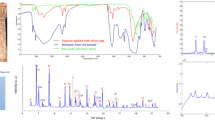Abstract
Nine black powders found in Pompeii houses in three different types of bronze vessels (cylindrical theca atramentaria, unguentaries, and aryballoi) were characterized in order to assess a correspondence between the composition and the type of vessel and, possibly, to verify if these powders were inks or not. For the compositional characterization, a multi-analytical approach was adopted, which involved the use of scanning electron microscopy–energy dispersive X-ray, Fourier-transformed infrared spectroscopy, Raman, X-ray diffraction, electron paramagnetic resonance spectroscopy, thermogravimetric analysis, gas chromatography coupled with mass spectrometry (GC/MS), and pyrolysis GC/MS. Powders contained in cylindrical theca atramentaria form a homogeneous group, and their organic and inorganic compositions suggest that they were writing inks, while powders contained in unguentaries and aryballoi could have had several different uses, including writing inks and cosmetics. Furthermore, the composition profile of the powders found in cylindrical cases shows that, at 79 ad, in Pompeii, carbon-based inks were still used for writing, and iron gall inks had not been introduced yet.

Photography of the 12724 black powder contained in a cylindrical theca atramentaria.







Similar content being viewed by others
References
Eerkens JW, Barnard H (2007) Theory and practice of archaeological residues analysis. In: Barnard H, Eerkens JW (eds) BAR International Series S1650. Archaeopress, Oxford
Ribechini E, Colombini MP, Giachi G, Modugno F, Pallecchi P (2009) A multi-analytical approach for the characterization of commodities in a ceramic jar from Antinoe (Egypt). Archaeometry 51(3):480–494
Lucas A, Harris JR (1962) Ancient Egyptian materials and industries, revised edition. Arnold E, Lucas A (1922) The Inks of Ancient and Modern Egypt. The Analyst 47: 9–14
Dioskurides PA (2005) De Materia Medica. Beck LY, translator, Hildesheim
Pliny the Elder (1983) Naturalis Historia. Latin text with Italian translation. Einaudi, Turin
Capella M (1978) De nuptiis philologiae et mercurii. Adolfus D, Stuttgart BGT (eds)
Nir-El Y, Broshi M (1996) The black ink of the Qumran Scrolls. DS Discoveries 3(2):157–167
Mc Crone Associates (2000) Ink analysis: the Gospel of Judas. www.mccroneassociates.com/case-studies/gospel-of-judas
Challinor JM (2001) Review: the development and applications of thermally assisted hydrolysis and methylation reactions. J Anal Appl Pyrolysis 61:3–34
Colombini MP, Giachi G, Modugno F, Pallecchi P, Ribechini E (2003) The characterization of paints and waterproofing materials from the shipwrecks found at the archaeological site of the Etruscan and Roman harbour of Pisa (Italy). Archaeometry 45(4):659–674
Lluveras A, Bonaduce I, Andreotti A, Colombini MP (2009) GC/MS analytical procedure for the characterization of glycerolipids, natural waxes, terpenoid resins, proteinaceous and polysaccharide materials in the same paint microsample avoiding interferences from inorganic media. Anal Chem 82(1):376–386
Aydas C, Engin B, Donmez EO, Belli O (2010) The use of ESR technique for assessment of heating temperatures of archaeological lentil samples. Spectrochim Acta Part A 75:466–473
Acknowledgements
The authors thank the Italian MIUR for financial support of the Project PRIN2007 “Colors and balms in antiquity: from the chemical study to the knowledge of technologies in cosmetics, painting and medicine” (Prot. 2007AKK9LX) and the “Soprintendenza Speciale per i Beni Archeologici di Napoli e Pompei” for permits granted.
Author information
Authors and Affiliations
Corresponding authors
Additional information
Published in the special issue Analytical Chemistry to Illuminate the Past with guest editor Maria Perla Colombini.
Rights and permissions
About this article
Cite this article
Canevali, C., Gentile, P., Orlandi, M. et al. A multi-analytical approach for the characterization of powders from the Pompeii archaeological site. Anal Bioanal Chem 401, 1801–1814 (2011). https://doi.org/10.1007/s00216-011-5216-8
Received:
Revised:
Accepted:
Published:
Issue Date:
DOI: https://doi.org/10.1007/s00216-011-5216-8




